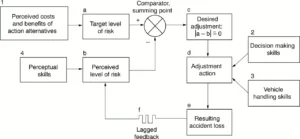 Bob O’Brien of DSCC chaired the panel sessionThe symposium’s first day, as well as its coverage of HUDs, concluded with a panel discussion, “Augmented Reality in Head-Up Displays for Automotive Displays, moderated by Bob O’Brien (Display Supply Chain Consultants). During the discussion, a questioner asked about vehicular dynamics and image latency. The questioner had run an experiment in which a conformal HUD system was vibrated at approximately 28 Hz. The system was “painting” AugRel lane markings over the real ones, and the vibration caused the AugRel imaging to lose its synchronization with the real markings.
Bob O’Brien of DSCC chaired the panel sessionThe symposium’s first day, as well as its coverage of HUDs, concluded with a panel discussion, “Augmented Reality in Head-Up Displays for Automotive Displays, moderated by Bob O’Brien (Display Supply Chain Consultants). During the discussion, a questioner asked about vehicular dynamics and image latency. The questioner had run an experiment in which a conformal HUD system was vibrated at approximately 28 Hz. The system was “painting” AugRel lane markings over the real ones, and the vibration caused the AugRel imaging to lose its synchronization with the real markings.
Panel member Dan Cashen of Daqri Automotive answered that maintaining sync under vibration or shock is very hard to do. “Our systems aren’t fast enough to keep up.”
Linda Angell, who worked at GM for 27 years and is now head of Touchstone Evaluations, suggested a work-around. Pilots use “tunnel in the sky graphics.” This kind of approach could require less strict synchronization than a “paint the road” model.
Cashen suggested using historical data from the vehicle. If the vehicle — and presumably its driver — had traversed a route many times before, perhaps we can assume the driver is so familiar with this road, there is no reason to supply him or her with lane-guidance visual aids. Or maybe we don’t need to show lane markings that are close to us. Maybe we show only those virtual lane markings that enhance real lane markings that are far enough way to be hard to see. What info does the driver need?
Said Joe Pullukat of NSI, “You could have a whole conference just on HMI design for HUDs.”
Cashen noted that 20% of accidents are related to perception errors, and that AR could help there. Seder had said earlier, “There are [nascent] systems that can tell the driver where he should look and where he should look next.”
It was noted that time-synchronized information cuts down on clutter and gives information to the driver when he has the attention bandwidth to deal with it appropriately.
There seemed to be an assumption among some of the the panelists that because AR HUDs will increase safety, insurers would reduce rates for drivers who use them. In resisting that assumption, Bob O’Brien referred to a comment Tom Seder had made in his keynote address about risk homeostasis. The idea is that each driver has a risk envelope within which he or she is comfortable. It is possible that as AR HUD and other advances make cars safer, drivers will perceive themselves as being well within their risk envelopes and will engage in risky behaviors — such as aggressive driving or higher speeds — that will bring them closer to the edges of their envelopes. So, said O’Brien, maybe insurance companies would not see a reduction of risk and would not reduce rates. O’Brien and Cashen agreed that we need data to support the hypothesis that AR HUD will actually reduce accidents.
Wilde’s model of risk homeostasis suggests that better driver aids may tempt them to increase their driving speed.

